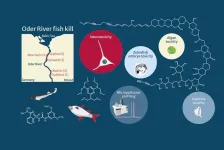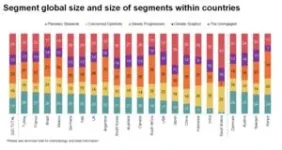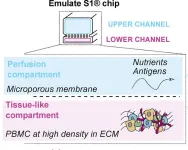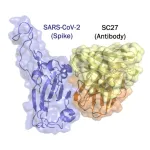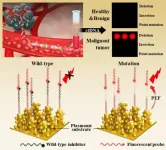(Press-News.org) Summer 2022’s environmental disaster led to the death of up to 60 per cent of fish biomass and up to 85 per cent of mussel and snail biomass in the River Oder. In August 2022, the UFZ set up an interdisciplinary ad hoc working group together with researchers from the Leibniz Institute of Freshwater Ecology and Inland Fisheries (IGB), the University of Veterinary Medicine, Vienna (Vetmeduni) and the University of Birmingham. They took water samples at five locations along the Oder, extracted poisoned fish and analysed and evaluated the samples. "The aim of the study was to find out which micropollutants are in the Oder, how they affect aquatic organisms in the river and what threat the cocktail of algal toxins and micropollutants could pose to humans," says Prof Dr Beate Escher, lead author and environmental toxicologist at the UFZ.
As the researchers now explain in the scientific journal Nature Water, they were able to detect more than 120 organic micropollutants in the water samples. The highest concentrations of chemical substances were found for the flame retardant tris(1-chloro-2-propyl)phosphate, the polymer additive hexamethoxymethylmelamine and the corrosion inhibitor 1H-benzotriazole. Most of the pollutants detected were presumably discharged into the Oder from sewage treatment plants, but their concentrations were low. However, the scientific team also found pollutants such as 2,4-dichlorophenol, which were probably discharged from industry, as well as pesticides and their degradation products, such as chlorotoluron, which were discharged directly into the water from agricultural land. "The concentrations of these chemicals are not unusually high, but are typical for European rivers”, says Beate Escher. “They did not lead to fish mortality, but together with the algal toxins they can lead to additional stress for aquatic organisms."
The researchers used the risk quotient RQ to analyse the extent of this stress and thus the risk of the detected pollutants for aquatic organisms. The RQ is defined as the ratio between the measured concentration of a pollutant and its predicted no effect concentration (PNEC). If the RQ exceeds the value of 1, the pollutant can affect aquatic life. The researchers added up the RQs of the detected chemicals and thus obtained mixture risk quotients (RQmix) of between 16 and 22 at the sampling sites. "All RQmix values significantly exceeded the threshold value of 1, which indicates a potential risk to aquatic organisms from pollutants," says co-author and water chemist Dr Stephanie Spahr from IGB. Only 30 organic micropollutants were included in the model, although thousands of organic chemicals are probably present in the river. The chemical cocktails extracted from the water samples also showed clear effects in laboratory experiments with algae, water fleas and zebrafish embryos, which are considered common models for aquatic organisms.
The researchers investigated how these pollutants and the prymnesins found in the Oder interact as mixtures in water extracts using neurotoxic effects on human nerve cells in vitro. "This test, which is commonly used in bioanalysis and water quality assessment, does not aim to assess the risk to human health, but rather to identify the mixture effects of neurotoxic chemicals," says Beate Escher. Assistant Professor Dr Elisabeth Varga, a food and environmental analyst at VetMedUni Vienna, provided an algal toxin standard that is very similar to the prymnesins identified in the Oder. The in vitro assays are carried out at the UFZ in automated high-throughput screening in the modern CITEPro technology platform in very small volumes. "It was therefore possible to test this prymnesin standard and other detected micropollutants as well as the water extracts directly," says Beate Escher. Even at very low concentrations in the nanomolar range, prymnesins shortened the outgrowths of nerve cells that are responsible for signal transmission and killed the cells.
In addition, many organic micropollutants quantified in the water extracts were analysed: several substances were neurotoxic, but at significantly higher doses. "Through mixture modelling and comparisons of the neurotoxicity measured in the extracts, we were able to show that prymnesins dominate the neurotoxic effect. However, the micropollutants we detected also contributed to this," says Elisabeth Varga. However, the effects of pollution on aquatic organisms in rivers such as the Oder could ultimately be much greater. "The prymnesins have a very high proportion of the cocktail effects, which are exacerbated by micropollutants. This puts even more pressure on the entire ecosystem of the Oder, which is already under great stress," says Beate Escher. And Prof Dr Luisa Orsini, co-author and Professor of Evolutionary Systems Biology and Environmental Omics at the University of Birmingham, adds: "The warmer temperatures and extreme weather events caused by climate change can make such toxic algal blooms an even greater risk for inland and marine waters and the population."
END
A chemical cocktail of micropollutants amplified the effect of algal toxins causing mass fish mortality on the River Oder in 2022
International research team has identified more than 120 organic micropollutants and investigated their role in damaging aquatic organisms
2024-09-06
ELSE PRESS RELEASES FROM THIS DATE:
Generative AI in cancer imaging: revolutionizing detection & diagnosis
2024-09-06
“This editorial explores its impact on expanding datasets, improving image quality, and enabling predictive oncology.”
BUFFALO, NY- September 6, 2024 – A new editorial was published in Oncotarget's Volume 15 on September 4, 2024, entitled, “Generative AI in oncological imaging: Revolutionizing cancer detection and diagnosis.”
Generative AI is revolutionizing oncological imaging, enhancing cancer detection and diagnosis. This editorial explores its impact on expanding ...
Disparity in access to medications for opioid use disorder persist in criminal legal settings
2024-09-06
EMBARGOED FOR RELEASE UNTIL 11 A.M. ET FRIDAY, SEPTEMBER 6. 2024
Individuals involved in the criminal legal system have a high rate of opioid use disorder (OUD) and a high risk of overdose death compared to the general population, yet the most effective treatments—medications for opioid use disorder (MOUD)—are underutilized in criminal legal settings where treatment is mandated as part of a person’s probation or parole. Medications are often not provided due to stigma or lack of adequate funding for evidence-based care. According to a study ...
Age-related changes in male fibroblasts increase treatment-resistant melanoma
2024-09-06
Age-related changes in the fibroblasts, cells that create the skin’s structure, contribute to the development of aggressive, treatment-resistant melanoma in males, according to research in mice by the Johns Hopkins Kimmel Cancer Center.
The study was published online Sept. 6 in Cell.
The risk of developing melanoma, a potentially deadly skin cancer, increases with age. Men are more at risk than women, and tend to develop more aggressive, hard-to-treat melanomas, particularly at advanced ages, says Ashani Weeraratna, Ph.D., the Bloomberg ...
COVID-19 and rates of cancer diagnosis in the US
2024-09-06
About The Study: This population-based cross-sectional study of U.S. cancer incidence trends found that rates of diagnosis improved in 2021 but continued to be lower than expected, adding to the existing deficit of diagnosed cases from 2020. Particular attention should be directed at strategies to immediately increase cancer screenings to make up lost ground.
Corresponding Author: To contact the corresponding author, Krystle A. Lang Kuhs, PhD, MPH, email krystle.kuhs@uky.edu.
To access the embargoed study: Visit our For The Media website at this link https://media.jamanetwork.com/
(doi:10.1001/jamanetworkopen.2024.32288)
Editor’s Note: Please see ...
New research from Swansea University shines a light on how solar power and farming can coexist
2024-09-06
Scientists from Swansea University have developed a new tool to help identify optimal photovoltaic (PV) materials capable of maximising crop growth while generating solar power.
In a recent study published in Solar RRL, academics from the University’s Department of Physics have been exploring the effect of semi-transparent PV materials placed over crops – an exemplary application of agrivoltaics (solar panels combined with agricultural settings).
As part of this work, the team has developed an innovative freeware tool that predicts the light transmission, absorption, and power generation of different PV materials nearly anywhere on the globe using ...
Artificial lymphoid organs could help predict efficacy of booster vaccines
2024-09-06
Researchers at the Institut Pasteur in France have developed artificial “lymphoid organ-chips” that recreate much of the human immune system’s response to booster vaccines. The technology, described in an article to be published September 6 in the Journal of Experimental Medicine (JEM), could potentially be used to evaluate the likely effectiveness of new protein and mRNA-based booster vaccines for COVID-19 and other infectious diseases.
The rapid mutation and evolution of SARS-CoV-2 and other viruses ...
One antibody to neutralize them all?
2024-09-06
SAN ANTONIO -- A monoclonal antibody appears effective at neutralizing the numerous variants of SARS-CoV-2, as well as related viruses in animals that could pose a threat if they were to begin spreading in people. The antibody, called SC27, was recently described in Cell Reports Medicine.
The finding opens the possibility of broader, more effective treatments to work against current and future COVID variants.
Monoclonal antibody SC27 was identified, developed and provisionally patented by a team of researchers led ...
How context-specific factors control gene activity
2024-09-06
Every cell in our body contains the same DNA, yet liver cells are different from brain cells, and skin cells differ from muscle cells. What determines these differences? It all comes down to gene regulation; essentially how and when genes are turned on and off to meet the cell’s demands. But gene regulation is quite complex, especially because it is itself regulated by other parts of DNA.
Gene regulators: Enhancers, transcription factors
There are two important components that control gene regulation: the first are enhancers, which are short bits of DNA that increase the likelihood that a ...
Detects cancer genes with ultra-high sensitivity!
2024-09-06
Dr. Min-young Lee and Dr. Sung-gyu Park of the Advanced Bio and Healthcare Materials Research Division at KIMS have developed a technology that can detect cancer mutant genes in blood with the world's highest sensitivity of 0.000000001% based on plasmonic nanomaterials for optical signal amplification. The team tested blood samples from lung cancer patients (stages 1-4) and healthy individuals for EGFR mutations and achieved a diagnostic accuracy of 96%.
Previously utilized genetic analysis technologies had low analytical sensitivity to detect mutated genes compared to normal genes, making it difficult to accurately diagnose early-stage cancer patients. ...
Study suggests US droughts, rainy extremes becoming more severe
2024-09-06
COLUMBUS, Ohio – Severe drought in the American Southwest and Mexico and more severe wet years in the Northeast are the modern norm in North America, according to new research – and the analysis suggests these seasonal patterns will be more extreme in the future.
The middle of the United States, meanwhile, can expect bigger swings between wetter wet periods – high-rainfall years known as pluvials – and drier summers through the rest of this century, the study predicts.
Researchers at The Ohio State University say the findings, based on modern precipitation data, historical tree rings and climate models ...
LAST 30 PRESS RELEASES:
Low daily alcohol intake linked to 50% heightened mouth cancer risk in India
American Meteorological Society announces Rick Spinrad as 2026 President-Elect
Biomass-based carbon capture spotlighted in newly released global climate webinar recording
Illuminating invisible nano pollutants: advanced bioimaging tracks the full journey of emerging nanoscale contaminants in living systems
How does age affect recovery from spinal cord injury?
Novel AI tool offers prognosis for patients with head and neck cancer
Fathers’ microplastic exposure tied to their children’s metabolic problems
Research validates laboratory model for studying high-grade serous ovarian cancer
SIR 2026 delivers transformative breakthroughs in minimally invasive medicine to improve patient care
Stem Cell Reports most downloaded papers of 2025 highlight the breadth and impact of stem cell research
Oxford-led study estimates NHS spends around 3% of its primary and secondary care budget on the health impacts of heat and cold in England
A researcher’s long quest leads to a smart composite breakthrough
Urban wild bees act as “microbial sensors” of city health.
New study finds where you live affects recovery after a hip fracture
Forecasting the impact of fully automated vehicle adoption on US road traffic injuries
Alcohol-related hospitalizations from 2016 to 2022
Semaglutide and hospitalizations in patients with obesity and established cardiovascular disease
Researchers ‘listen in’ to embryo-mother interactions during implantation using a culture system replicating the womb lining
How changing your diet could help save the world
How to make AI truly scalable and reliable for real-time traffic assignment?
Beyond fragmented markets: A new framework for efficient and stable ride-pooling
Can shape priors make road perception more reliable for autonomous driving?
AI tracks nearly 100 years of aging research, revealing key trends and gaps
Innovative techniques enable Italy’s first imaging of individual trapped atoms
KIER successfully develops Korea-made “calibration thermoelectric module” for measuring thermoelectric device performance
Diversifying US Midwest farming for stability and resilience
Emphasizing immigrants’ deservingness shifts attitudes
Japanese eels, climate change, and river temperature
Pusan National University researchers discover faster, smarter heat treatment for lightweight magnesium metals
China’s 2024 Gastroenterology Report: marked progress in endoscopy quality and disease management
[Press-News.org] A chemical cocktail of micropollutants amplified the effect of algal toxins causing mass fish mortality on the River Oder in 2022International research team has identified more than 120 organic micropollutants and investigated their role in damaging aquatic organisms
